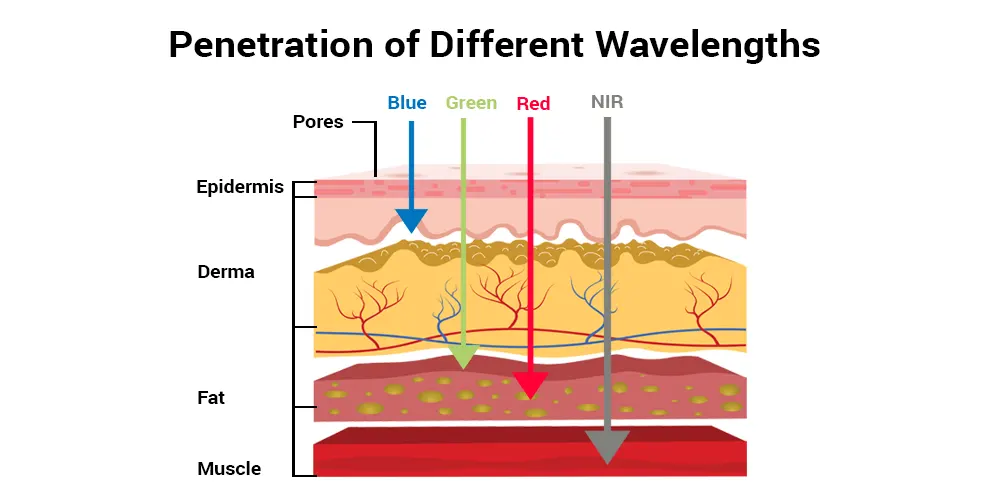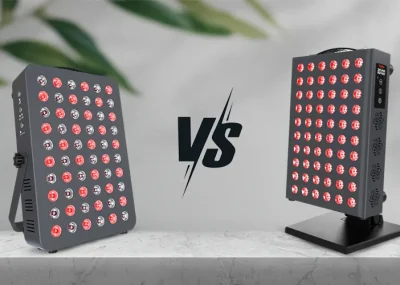Understanding the Mechanism of Red-Light Penetration
Red light therapy sessions basically involve exposing the body and skin to near-infrared or low levels of light, which works by stimulating the body’s cellular function and promoting healing. However, one thing that most people ask is whether this red-light treatment can still be effective if they undergo the therapy sessions with their clothes on.
It is worth noting that the efficiency of this innovative therapy is determined by how much light can penetrate and reach the targeted area. If a higher amount of red light can penetrate the clothes and reach the targeted area, the more efficient the treatment will be. Incorporating the specific benefits of 660nm wavelength red light therapy into your routine can further enhance treatment outcomes.
Red light therapy makes use of specific red-light wavelengths to have a positive effect on the body. The near-infrared and red wavelengths range are the most common and preferred because of their ability to interact with mitochondria in the body cells, hence triggering a flow of beneficial health effects.
The penetration capability of red-light therapy is a topic that Theodore A. Henderson and Larry D. tried to explore in a study shared in the Journal of Neuropsychiatric Disease and Treatment. Ideally, good penetration offers many key health benefits including improved skin health, enhanced muscle recovery, reduced inflammation, pain relief, enhanced mood, improved sleep, and much more.
Red Light Penetration Capability
Penetration capability is one of the vital aspects of red-light therapy because it determines how light can penetrate deep into the body.
One review study in the National Library of Medicine Journal by Jared R. Jagdeo et al. shows that near-infrared and red light can penetrate a number of centimeters under the surface of the skin, reaching muscles, tissues, and bones.
However, the depth of penetration is likely to vary depending on a number of factors like specific wavelength, light source power, and pigment concentration or substance in the tissue.
We consulted Guy Odishaw a Bioelectric Medicine Practitioner, He explains red light therapy can penetrate the skin at a depth of approximately 8-10 millimeters. This means that it is able to reach the dermis and some layers of subcutaneous tissue, making it effective for treating various skin conditions. It can also reach muscle tissue, making it useful for pain management.
The Effect of Clothing on Red Light Therapy
Red light therapy is an effective and safe treatment procedure if applied the right way. However, some things are often overlooked when applying this type of technology treatment that affect its efficiency.
Clothing, for instance, can be a big barrier to red light penetration, hence reducing the effectiveness of treatment. Some clothes like thin and light-colored clothes can allow penetration of light, dark and thick fabrics substantially blocking light penetration in general. Some literature notes that red light therapy may work through clothes, but there are fabric materials or colors that may reduce the treatment efficiency.
So, to maximize red light therapy’s health benefits, direct skin exposure to red light therapy treatment is recommended. Always keep away from any obstruction that clothing may cause during red light therapy sessions.
 Penetration of Different Wavelengths
Penetration of Different WavelengthsChoice of Clothing When Using a Red-Light Gadget
The choice of clothes matters a lot when you are planning to undergo a red light therapy session. Maximum light penetration into the skin is vital because it is the only way you can get optimal benefits from red light therapy sessions.
According to an article published in Heat for Pain Relief, it is important to consider dressing options that allow enough light to pass through. Thicker and darker clothes may block light penetration while shiny clothes are known to reflect light.
The effectiveness of red light therapy through clothing or bandages is dependent on the material’s thickness and color. Lighter, thinner materials may allow some light to penetrate, says Dr. Anna Chacon as we spoke to her. She further added that the therapy’s effectiveness will likely be reduced. For optimal results, it’s generally recommended to apply red light therapy directly to the skin.
Experts recommend wearing loose-fitting and lightweight clothes allowing enough light penetration while it provides privacy and modest comfort.
Targeted Body Regions for Red Light Therapy Through Clothes
While direct skin exposure to red light is the best way of ensuring that light gets through the skin into the target area, there are some parts of the body where one can still achieve optimal therapeutic benefits with clothes on.
An example of such body areas is sparse hair coverage and thinner skin like the neck face, and hands. Skin in these areas lets greater light penetration including through lightweight clothes. So, it is still possible for you to get the benefits of red light therapy with some level of dressing coverage.
Red light therapy does offer several health benefits to the body and they range from reduced pain and inflammation to improved skin health.
While dressing can reduce the effectiveness of therapy by partially blocking light, strategic choices like targeting thinner skin areas or making use of larger panels can be a great help in overcoming this limitation.
Red Light Therapy Through Clothing: Factors to Consider
There are several factors you need to consider about clothing if you are considering starting red light therapy treatment. Some of these key factors are discussed below:
1. Clothing Color and Red Light
The color of the dressing can affect light absorption capacity due to its ability to block or reflect light. According to an article published in Cureus, dark-colored fabrics are said to block light from penetrating the skin while light-colored ones do reflect the light, hence both obstruct light from traveling through the garment to reach the skin.
2. Clothing Thickness
Fabric thickness can also enhance or hinder light penetration. Thin, lightweight garments are likely to allow red light transmission, hence optimizing therapy outcomes. On the contrary, thicker fabrics like heavy knits or denim may interfere with light transmission thus reducing the effectiveness of the light treatment.
3. Fabric Material and Red Light Penetration
The clothing material also plays a crucial role in determining red light therapy effectiveness through clothes. Fiber from natural material like linen and cotton, tend to have a better light penetration compared to synthetic materials. So, opting for garments made from breathable fabrics is highly recommended as such clothes allow optimal light transmission.
How to Get The Most from Red Light Therapy Through Clothing?
If you are planning to go through red light therapy sessions with your clothes on, here are some of the choices you can make if you want to get the most out of the treatment:
- Loose-Fitting Garments: Loose-fitting clothes are a better option if you are planning to have red light therapy with your garments on. This is because loose clothes allow enough light penetration without bringing about discomfort or limiting movement. They ensure that there is better contact and consistent coverage between the red light therapy device and the skin.
- Avoid Excess Layering: Excessive layering has also been seen to interfere with light penetration. So, if you plan to have red light therapy while having your clothes on, you should keep your clothes layers to the minimum because if not, it will reduce the potential benefits of the therapy. Minimizing clothing layers will ensure optimal light transmission, hence benefitting more from the treatment.
- Use Thinner Fabrics: Thinner fabrics are crucial if you want to get the most out of red light therapy sessions. Opting for breathable and lighter fabrics will ensure minimal red light wavelength obstruction, thus allowing the light to easily reach the targeted areas. This makes the therapy more effective.
Frequently Asked Questions
Does Red Light Therapy Go Through Clothing?
A: Red light therapy may not effectively penetrate through the bandages or clothing. However, infrared light which is not visible to the eyes can penetrate through the bandages and clothes.
However, while near-infrared light can penetrate through clothing, some clothes may have a varying impact on the light treatment.
While near-infrared light can penetrate through clothing, some clothes may have a varying impact on the light treatment. So, optimal results can only be achieved if the treatment is done directly to the skin. A publication in Leredd.com notes that wearing clothes during red light therapy sessions may prevent near-infrared or red light from penetrating deeply into the target area.
For optimal results, the treatment should be done with your clothes off so that the light can directly reach the skin without obstruction. You may have your underwear or bra on but take note that such areas may not benefit from the treatment like other exposed areas.
What Fabric Color Allows Red Light Penetration?
A: According to a publication in Bonttany.com, the fabric you wear and its color play a crucial role during red light therapy sessions. There are fabrics that have better penetration of red light wavelengths while others are known to block or reflect the light, hence affecting treatment efficiency.
So, when choosing clothes, ensure that they are the right type that will help you reap the benefits that come with red light therapy treatment. Breathable and light fabrics like linen or cotton, for example, have been found to allow better red light wavelength penetration.
Choose loose–fitting and light-colored clothes made using breathable materials like bamboo or cotton. Tight clothes may limit optimal body exposure to light hence reducing the intended health benefits. Also, keep off clothes that reflect or block light because such shiny and dark materials or fabrics are thick and may limit the penetration of light.
How Deep Does Red Light Therapy Penetrate?
A: Red light of wavelength between 630nm and 640 nm has been found to penetrate the human tissue with about 80% of the energy getting absorbed in the first 2cm. However, red light therapy can benefit the whole body including ligaments, skin, and muscles more on if it can infiltrate deep enough.
If for instance, you are targeting the brain, the light has to move through the skin, bones, and tissues before reaching the brain. Compared to other lights, red light therapy is considered the best healing light therapy that is capable of penetrating deeper while maintaining enough energy to provide the intended healing effect in the target area.
In general light wavelengths penetration vary depending on the condition you are treating. Skin cells, for instance, will benefit more when exposed to slightly shorter red light wavelength while inner organs like the brain may require deeper wavelength (like near-infrared).
Does Cotton Block UV Rays?
A: Cotton if not bleached is very effective in absorbing UV rays. However, most cotton available cotton clothes are no longer effective because the manufacturing process they go through often degrades their natural lignin meant to provide protection against UV rays. So, most cotton clothes are bleached and so, no longer able to offer enough UV rays protection.
Conclusion
Red light therapy is a non-invasive, affordable, and safe type of treatment with immense health benefits to the body. The health benefits of using this innovative treatment may range from pain relief, and skin health improvement, to mood regulation and quality sleep.
However, when having a red light therapy session through clothes, some practical considerations regarding fabric material, color, and thickness may be of great importance because they will ensure optimal therapy efficiency.
As noted above, selecting loose-fitting garments made from lightweight and breathable materials is important as it will help maximize red light wavelength penetration during therapy sessions. This means that you will be able to get a better experience and optimize on potential health benefits of this state–of–the–art therapy.












